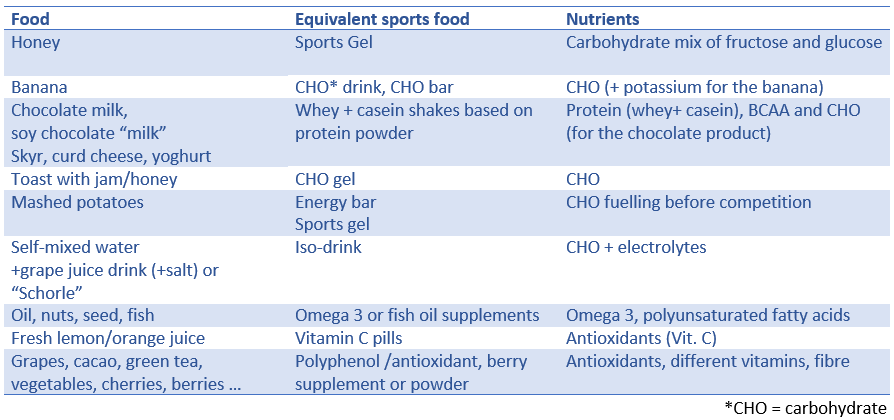
Back to the roots: the “food-first” approach
What is the “food-first” approach?
As a sports dietician, the challenge is to join scientific knowledge with practical feasibility, respecting the joy of food and gustative preferences of athletes. Using the food-first approach means taking food to get nutrients in a natural, fresh and seasonal manner, getting ergogenic effects with “real” food. Education and information play an important role.
Why should athletes adopt a whole-food philosophy?
Athletes want to reach best performances, go through hard training sessions with the aim to get better, faster and stronger. The actual trends often encourage the use sports food and supplements which tend to take more space in the suitcase than sports equipment and the market is a jungle. While some of these products might be a convenient solution under some conditions, most of the athletes can also fuel properly with the right “natural” food.
Check the advantages of a banana as a power bar, milk as recovery drink or juices (or “Schorle”) as carbo-loader:
In the image beneath are some examples of natural food as an alternative to sports food or supplements.
The effects on immune system, performance and recovery of natural food are as good as with sports food or supplements, as it can be illustrated with many different food, such as chocolate milk (Upshaw et al., 2016) and banana (Nieman et al., 2012).
In some cases, sports food or supplements can be useful as a second choice or complementary to a well-balanced diet:
– athletes with high energy or micronutrient demands, when the quantity of food to eat is not feasible
– very specific diets (allergies; intolerances; low residue diet, …)
– need of exact information on nutritional composition
– To tackle availability + delivery challenges, for example while travelling
All in all, nutrition plans should be built up from a balanced-diet first, followed by sport-specific adaptations before adding sports food or supplements where they are needed and justified by doctors or sports dieticians with an evidence-based approach. For a long-term compliance to effective nutrition plans, a healthy mix can sustain diet diversity for athletes.
Further scientific information:
Alcantara, J. M. A. et al., (2019). Impact of cow’s milk intake on exercise performance and recovery of muscle function: A systematic review. Journal of the International Society of Sports Nutrition, 16(1), 1–11.
Born, K. A. et al., (2019). Chocolate Milk versus carbohydrate supplements in adolescent athletes: A field based study. Journal of the International Society of Sports Nutrition, 16(1), 4–11.
Bowtell, J., & Kelly, V. (2019). Fruit-Derived Polyphenol Supplementation for Athlete Recovery and Performance. Sports Medicine, Vol. 49, pp. 3–23.
Burd, N. A. et al., (2019). Food-First Approach to Enhance the Regulation of Post-exercise Skeletal Muscle Protein Synthesis and Remodeling. Sports Medicine, Vol. 49, pp. 59–68.
Hills, S. P. et al., (2019). Honey supplementation and exercise: A systematic review. Nutrients, Vol. 11. https://doi.org/10.3390/nu11071586
Nieman, D. C. et al., (2012). Bananas as an energy source during exercise: A metabolomics approach. PLoS ONE, 7(5).
Salvador, A. F. et al., (2019). Potato ingestion is as effective as carbohydrate gels to support prolonged cycling performance. Journal of Applied Physiology, 127(6), 1651–1659.
Upshaw, A. U. et al., (2016). Cycling time trial performance 4 hours after glycogen-lowering exercise is similarly enhanced by recovery nondairy chocolate beverages versus chocolate milk. International Journal of Sport Nutrition and Exercise Metabolism, 26(1), 65–70.


